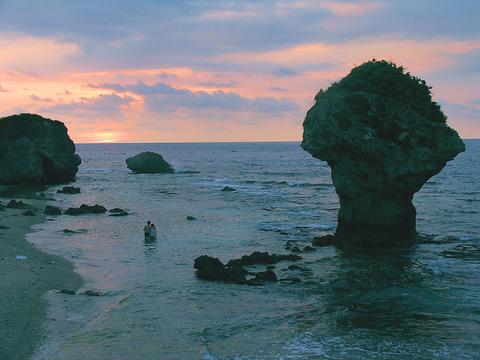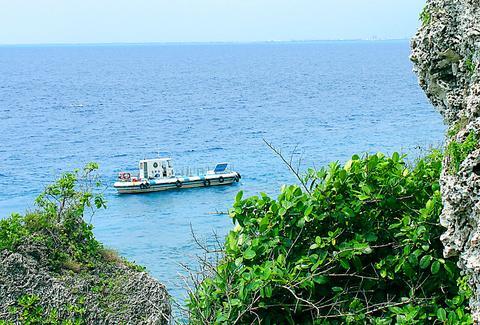Few of Taiwan's tourist destinations have the natural assets of Hsiao Liuchiu, (
A quick ride around the island reveals why: nearly every plot of "undeveloped" land has been taken up by graves. What's more, the nicer the plot -- with, say, a postcard view of the setting sun -- the more graves there are.
Liuchiu, as residents call it, is just 6.8km2 with a population of some 13,000 residing in eight villages. With just 10 surnames between them, they are keenly aware of just whose graves occupy their backyards. Most residents live on the northern side of the island near the harbor closest to Kaohsiung. The southern half of Liuchiu is mostly graves, interrupted by either an occasional village or one of the giant coral rock formations of which the island is composed.

PHOTO: DAVID MOMPHARD, TAIPEI TIMES
The living and dead so closely cohabitate the island that it is, in fact, against the law. Regulations established by the Ministry of the Interior state that burials cannot take place within 500m of a residence. But on an island that is just 4,000m long and 2,000m across, obeying this law would be next to impossible.
"Liuchiu has two problems," said Chen Chen-hua (陳振華), who operates a seaside resort and campground, the island's newest tourist development, "All the young people go over there," he says pointing to Kaohsiung on the horizon, "and all the old people go over there," he says pointing to the south of the island.
Chen explains that the young people leave mostly for better job opportunities on Taiwan, but also to escape an island famous for its ghosts.

PHOTO: DAVID MOMPHARD, TAIPEI TIMES
One of the main tourist attractions on Liuchiu is Black Spirit Cave (烏鬼洞), a sea-side park area made famous for its picturesque scenery and the story of what happened there centuries ago.
The story is carved in stone near the cave's entrance: "It was in 1661 (the 15th year of the Yong Li Ming Dynasty) national hero Koxinga (Cheng Chen-kung, 鄭成功), knighted as Yen Ping King, drove the Dutch and restored Taiwan and the Pescadores (Penghu). During the Dutch escaping, some negroes were separated from their unit and arrived at this island. They lived in this cave. Some years later, a British boat with soldiers landed at the place northeast of the cave. As they were enjoying the scenery, those negroes robbed their food and other things, burned the boat and killed all the British. It was discovered by the British warship that they landed this island and sought the murderers while the negroes hid in the cave. In spite of many threats, they refused to surrender. Finally, the British burned the cave with oil. Then, all the negroes died there in the cave. Later it was named as the Black Spirit Cave, which means the cave in which the foreign negroes had lived before. ...."
The inscription ends with a nod to Liuchiu's tourism ambitions: "To add more beauty for this island and to meet the development of tourism, we rebuilt it in the form of public building and made it more enjoyable."
Scholars now believe that the "negroes" in the story were actually Siraya Aborigines, who were related to tribes that lived in the area that is now Pingtung County as far back as 3,000 years ago.
Another of the island's main attractions is Beauty Cave (美人洞), named for the young daughter of a Ming loyalist who fled China to escape Manchu forces. He and his daughter hid out in this catacomb of coral grottoes, surviving off wild plants and fish until the day the father died. Local inhabitants later discovered the young girl weeping over her father's body. But rather than leave his side, according to the legend, she bit her tongue in half and took her own life.
The most remote of these grottoes is, yet again, famous for a tragic reason. It was the sight where, in the last century, locals disposed of unwanted baby girls. It's now marked by a shrine built in the girls' honor.
But ghost stories and tragic tales are hard to think of when the sun kisses the coral shores of Liuchiu and winks from the tops of waves. At the island's peak, on a clear day, it's possible to trace Taiwan's coastline from Kaohsiung in the north down the Hengchun Peninsula in the south. The living coral beneath the sea and the coral rock inland on the island mean adventure-seekers could spend several days getting happily lost. The beauty of Liuchiu is as beguiling as its ghost stories.

Exceptions to the rule are sometimes revealing. For a brief few years, there was an emerging ideological split between the Democratic Progressive Party (DPP) and Chinese Nationalist Party (KMT) that appeared to be pushing the DPP in a direction that would be considered more liberal, and the KMT more conservative. In the previous column, “The KMT-DPP’s bureaucrat-led developmental state” (Dec. 11, page 12), we examined how Taiwan’s democratic system developed, and how both the two main parties largely accepted a similar consensus on how Taiwan should be run domestically and did not split along the left-right lines more familiar in

This month the government ordered a one-year block of Xiaohongshu (小紅書) or Rednote, a Chinese social media platform with more than 3 million users in Taiwan. The government pointed to widespread fraud activity on the platform, along with cybersecurity failures. Officials said that they had reached out to the company and asked it to change. However, they received no response. The pro-China parties, the Chinese Nationalist Party (KMT) and Taiwan People’s Party (TPP), immediately swung into action, denouncing the ban as an attack on free speech. This “free speech” claim was then echoed by the People’s Republic of China (PRC),

As I finally slid into the warm embrace of the hot, clifftop pool, it was a serene moment of reflection. The sound of the river reflected off the cave walls, the white of our camping lights reflected off the dark, shimmering surface of the water, and I reflected on how fortunate I was to be here. After all, the beautiful walk through narrow canyons that had brought us here had been inaccessible for five years — and will be again soon. The day had started at the Huisun Forest Area (惠蓀林場), at the end of Nantou County Route 80, north and east

Specialty sandwiches loaded with the contents of an entire charcuterie board, overflowing with sauces, creams and all manner of creative add-ons, is perhaps one of the biggest global food trends of this year. From London to New York, lines form down the block for mortadella, burrata, pistachio and more stuffed between slices of fresh sourdough, rye or focaccia. To try the trend in Taipei, Munchies Mafia is for sure the spot — could this be the best sandwich in town? Carlos from Spain and Sergio from Mexico opened this spot just seven months ago. The two met working in the